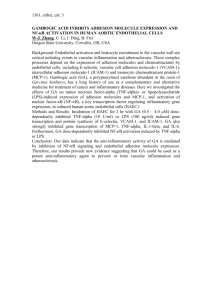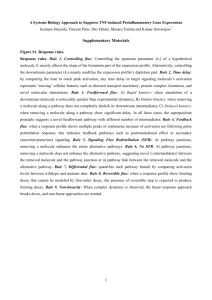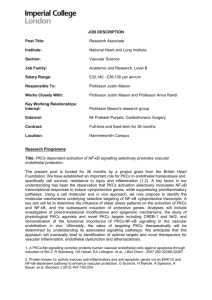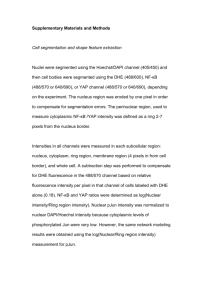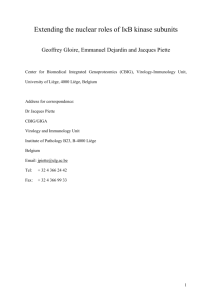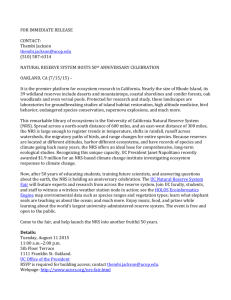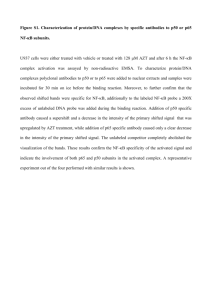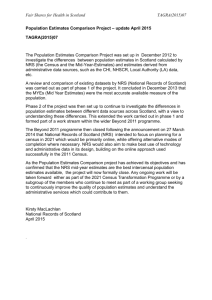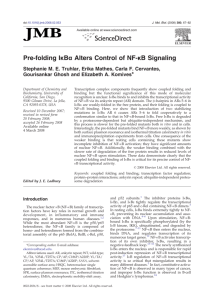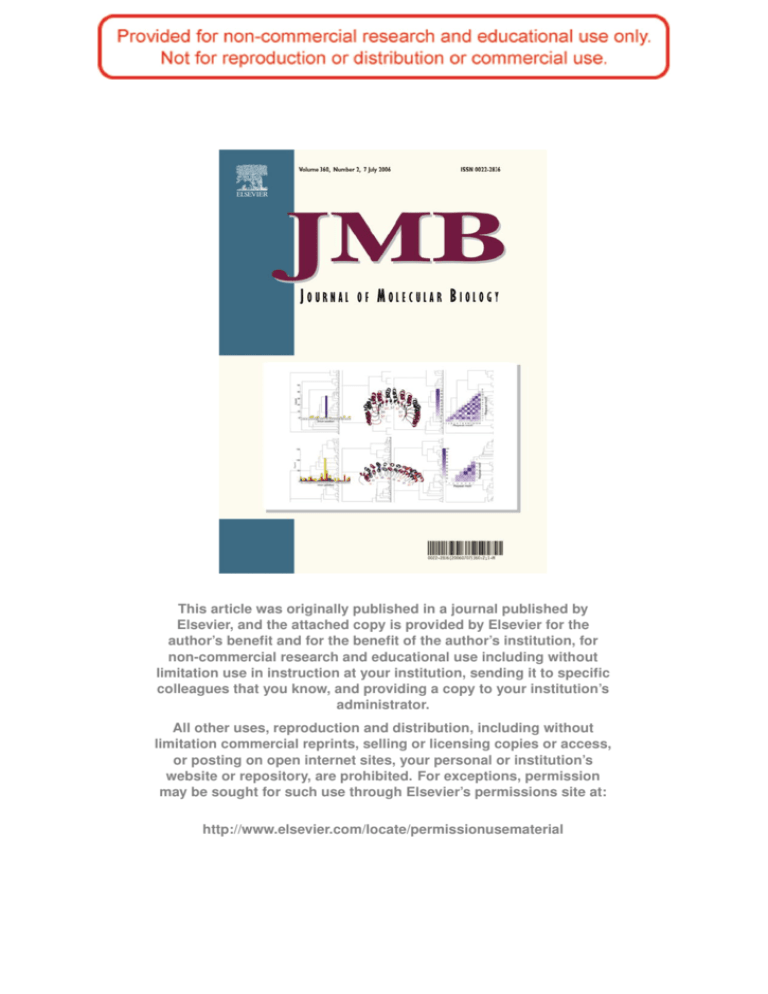
This article was originally published in a journal published by
Elsevier, and the attached copy is provided by Elsevier for the
author’s benefit and for the benefit of the author’s institution, for
non-commercial research and educational use including without
limitation use in instruction at your institution, sending it to specific
colleagues that you know, and providing a copy to your institution’s
administrator.
All other uses, reproduction and distribution, including without
limitation commercial reprints, selling or licensing copies or access,
or posting on open internet sites, your personal or institution’s
website or repository, are prohibited. For exceptions, permission
may be sought for such use through Elsevier’s permissions site at:
http://www.elsevier.com/locate/permissionusematerial
doi:10.1016/j.jmb.2006.05.014
J. Mol. Biol. (2006) 360, 421–434
py
Thermodynamics Reveal that Helix Four in the NLS of
NF-κB p65 Anchors IκBα, Forming a Very Stable
Complex
Department of Chemistry,
University of Colorado, Boulder,
Boulder, CO 80309-0215, USA
3
pe
Department of Chemistry,
San Diego State University,
San Diego, CA 92182, USA
al
2
IκBα is an ankyrin repeat protein that inhibits NF-κB transcriptional activity
by sequestering NF-κB outside of the nucleus in resting cells. We have
characterized the binding thermodynamics and kinetics of the IκBα ankyrin
repeat domain to NF-κB(p50/p65) using surface plasmon resonance (SPR)
and isothermal titration calorimetry (ITC). SPR data showed that the IκBα
and NF-κB associate rapidly but dissociate very slowly, leading to an
extremely stable complex with a KD,obs of approximately 40 pM at 37 °C. As
reported previously, the amino-terminal DNA-binding domain of p65
contributes little to the overall binding affinity. Conversely, helix four of
p65, which forms part of the nuclear localization sequence, was essential for
high-affinity binding. This was surprising, given the small size of the
binding interface formed by this part of p65. The NF-κB(p50/p65)
heterodimer and p65 homodimer bound IκBα with almost indistinguishable thermodynamics, except that the NF-κB p65 homodimer was
characterized by a more favorable ΔHobs relative to the NF-κB(p50/p65)
heterodimer. Both interactions were characterized by a large negative heat
capacity change (ΔCP,obs), approximately half of which was contributed by
the p65 helix four that was necessary for tight binding. This could not be
accounted for readily by the small loss of buried non-polar surface area and
we hypothesize that the observed effect is due to additional folding of some
regions of the complex.
on
Department of Chemistry and
Biochemistry, University of
California, San Diego 9500
Gilman Dr. La Jolla, CA
92093-0378, USA
rs
1
co
Simon Bergqvist 1 , Carrie H. Croy 2 , Magnus Kjaergaard 1 , Tom Huxford 3
Gourisankar Ghosh 1 and Elizabeth A. Komives 1 ⁎
Introduction
Keywords: ankyrin repeat; isothermal titration colorimetry; rel family; IκBα;
surface plasmon resonance
th
o
*Corresponding author
r's
© 2006 Elsevier Ltd. All rights reserved.
Au
In resting cells, NF-κB dimers with transcription
activation potential are sequestered in the cytoplasm, interacting with a family of inhibitors of
kappa B (IκBs) proteins.1 The nuclear factor kappa
B (NF-κB) is a family of transcription factors that
control cellular signaling, cellular stress responses,
cell growth, survival, and apoptosis.2–5 It is known
that at least 58 viral or bacterial products, some 46
Abbreviations used: NLS, nuclear localization signal;
AR, ankyrin repeat; EMSA, electrophoretic mobility-shift
assay; SPR, surface plasmon resonance; ITC, isothermal
titration calorimetry.
E-mail address of the corresponding author:
ekomives@ucsd.edu
stress conditions and chemicals, and at least 32
cytokines and receptor ligands, as well as apoptotic
mediators and mitogens, activate the NF-κB signaling system and subsequently the expression of
more than 150 target genes.6 IκBα is capable of
inhibiting many of the NF-κB family members,
including the most abundant p50/p65, and other
p65 and cRel-containing homo- and heterodimers.3
Following the action of a large number of different
stimuli, IκBα is phosphorylated, ubiquinylated,
and degraded, freeing the NF-κB nuclear localization signal (NLS) which targets the NF-κB to the
nucleus. In resting cells, the NF-κB/IκBα complex
appears to be stable.7 A hallmark of the NF-κB/
IκBα complex is its high level of stability in resting
cells, with a recent estimate of the IκBα half-life at
longer than 48 h (A. Hoffmann et al., unpublished
results). This tight regulation is critical, as only a
0022-2836/$ - see front matter © 2006 Elsevier Ltd. All rights reserved.
422
Au
th
o
co
al
on
r's
pe
rs
small amount of NF-κB, due to leaky inhibition, is
sufficient to give gene expression. This is confirmed
by a recent study that showed that upon stimulation, only a small fraction of cytoplasmic NF-κB
enters the nucleus and this results in transcriptional
activation.8
The crystal structure of NF-κB(p50/p65) bound
to IκBα was determined by two laboratories
simultaneously (Figure 1(a)).9,10 The structures
reveal an extended protein–protein interface
formed between IκBα and NF-κB, and provide a
structural basis for the studies presented here.
IκBα contains an ankyrin repeat domain, comprising six ankyrin repeat units, and a C-terminal
PEST region. Each ankyrin repeat consists of
about 33 residues and adopts a fold containing a
β-hairpin, followed by two anti-parallel α- helices,
followed by a short loop. The ankyrin repeat
domain of IκBα forms an extensive interface with
the NF-κB heterodimer, forming contacts in
multiple regions (Figure 1(b)), and burying more
than 4000 Å2 of surface area in the interface. The
two proteins run antiparallel with ankyrin repeat
1 (AR1) of IκBα, being capped by helix four of
NF-κB p65 (residues 305–321). AR1–AR3 contact
helix three (residues 289–300) of p65, and AR3–
AR6 and the first part of the IκBα PEST sequence
contact the NF-κB p50 and p65 dimerization
domains. The PEST sequence also contacts the
NF-κB p65 amino-terminal domain. Despite the
structural and biochemical information locating
the contacting surfaces, identification of the critical
determinants of binding affinity has eluded us.11
In this study, we address this important issue by
taking apart the NF-κB/IκBα complex and carrying out a detailed study of the binding thermodynamics. We have previously investigated the
interactions of the NF-κB dimers with IκBα by a
fluorescence polarization competition assay,12 and
an electrophoretic mobility-shift assay (EMSA).13
However, both techniques have potential limitations and so we have undertaken a more detailed
study by direct binding assays using surface
plasmon resonance (SPR) and isothermal titration
calorimetry (ITC).
The binding thermodynamics and kinetics were
measured for the interaction between IκBα and fulllength NF-κB(p50/p65) heterodimer as well as with
fragments of the NF-κB that were missing either the
N-terminal domain or helix four from the NLS
region. The interaction of IκBα with the p65
homodimer was also measured. These experiments
helped to identify regions of NF-κB that are critical
for tight binding affinity and they revealed the
thermodynamics that drive the interaction.
We demonstrated previously that the free IκBα is
highly dynamic in parts and only marginally stable
in solution.14 In the work presented here, we also
measured the temperature-dependence of the binding interaction to investigate the possibility of a
folding-upon-binding mechanism.
This study provides three important characteristics of the NF-κB/IκBα complex. First, the interac-
py
Thermodynamics of the NF-κB/IκBα Interaction
Figure 1. (a) Ribbon diagram showing the x-ray
crystal structure of the NF-κB/IκBα complex. IκBα is
colored blue. The NF-κB is colored to show the p50
subunit in green, the p65 RHR and dimerization domain in
red and the p65 NLS and NLS extension in violet. This
Figure was created using PyMOL v. 0.97 [http://pymol.
sourceforge.net/] for the PDB coordinates (PDB accession
code 1nfi)40. (b) A schematic to show the domain structure
of the NF-κB p50 (green) p65 (red) heterodimer.
tion has an extremely low dissociation rate, which
results in very high affinity and explains the long
half-life observed in vivo. Second, the affinity of the
423
Thermodynamics of the NF-κB/IκBα Interaction
interaction depends critically on the p65 NLS and
this explains how the NLS is effectively sequestered
by IκBα. Third, the thermodynamics help explain
how IκBα can be very stable in complex with NF-κB
and yet be degraded rapidly.
(Table 1A) with results for NF-κB(p50248-350/
p65190-321), lacking the amino-terminal domain
revealed an approximately twofold decrease in ka
and an approximate eightfold increase in kd and a
KD,obs of 3.2(±1.0) × 10−10 M (Table 1B). The faster
dissociation rate permitted data to be recorded at
25 °C (Figure 2(c)) as well as 37 °C (Table 1B) for this
complex. As expected, the dissociation rate was
significantly slower at 25 °C resulting in a KD,obs of
0.91(±0.27) × 10−10 M.
py
Results
IκBα forms a very stable complex with NF-κB
co
Helix four of NF-κB p65 plays a major role in the
slow dissociation rate of the complex
on
al
The C-terminal residues of NF-κB p65 contain
the NLS consensus sequence KRKR at residues
301–304. This region is flanked by two α-helices,
helix three (289–300) and helix four (305–321).
Together, these motifs are known as the NLS
domain (Figure 1(b)). We investigated the effect of
helix four of the NLS on binding. Initial SPR
experiments with NF-κB(p50 248-350 /p65 190-304 )
revealed that the IκBα dissociated orders of
magnitude faster; too fast to be quantified at
37 °C. At 25 °C (Figure 3(a)) and at 15 °C (Figure 3(c)),
the kd of IκBα was 100(±20) × 10−3 s −1 and 24
(±0.95) × 10−3 s−1, respectively, compared to 0.12
(±0.041) × 10−3 s−1 at 25 °C, for the longer construct
(Table 1). Due to the weaker binding affinity, data
were also analyzed by equilibrium analysis as
shown in Figure 3(b) and (d), respectively. The
results of the kinetic and equilibrium analyses were
in good agreement, confirming the reliability of
both modes of analysis. Thus, deletion of helix four
of the p65 NLS resulted in an increase of more than
1000-fold in kd. Including the decrease in ka that was
also observed, the affinity of IκBα for this complex
was decreased by approximately 10,000-fold by the
deletion of helix four of the NLS. Although the NFκBs that contained helix four bound too tightly to
measure the KD,obs accurately by ITC (Figure 2(d)),
the NF-κBs that did not contain helix four bound
weakly enough to allow direct comparison between
the ITC and SPR data (Figure 4(a) and Table 2). The
results showed good agreement between the two
experiments, especially considering the complex
nature of the two proteins involved. At 25 °C and
15 °C the KD,obs estimated by SPR was approximately four times and three times weaker, respectively, than that measured by ITC. The small
discrepancy probably results from an effect of the
surface change of the carboxymethyl dextran chip
or of the linker used to immobilize the NF-κB. An
electrostatic effect is more likely, since the IκBα
contains an excess of acidic residues in its Cterminus. The ITC study confirmed the observation
that the effect of the N-terminal domain on IκBα
binding affinity is small (Table 2 and Figure 4(b)).
Since the NF-κB NLS appeared to be so important
for binding, we generated synthetic peptides
spanning the regions of the p65 NLS. Three
peptides comprising residues 289–307, 289–314
and 289–320 were synthesized. Only the longest
th
o
r's
pe
rs
The binding kinetics and thermodynamics of the
IκBα/NF-κB interaction were investigated by SPR.
An N-terminal cysteine residue was introduced into
NF-κB(p65) and the NF-κB(p50248-376/p6519-325) heterodimer was biotinylated and immobilized on a
streptavidin chip. Sensorgrams reveal that the
IκBα/NF-κB interaction achieved high affinity by a
combination of a fast association rate and a slow
dissociation rate at 37 °C (Figure 2(a)) leading to a
KD,obs of 3.9(±0.3) × 10−11 M (Table 1A). Experiments
were carried out at 37 °C to speed the rate of
dissociation of IκBα, which was very slow at 25 °C,
relative to the baseline drift of the instrument. Even
at 37 °C the dissociation rate was very low, which
meant that we did not even begin to cover one halflife of the dissociation event within the 20 min
dissociation period. Thus, the dissociation rate we
report represents the upper limit of the true kd and
the true KD,obs for the complex may be even lower.
Disruption of the NF-κB/IκBα complex required a
1 min pulse of 3 M urea at 37 °C and 6 M urea at
25 °C for regeneration. It is noteworthy that the NFκB(p50/p65) heterodimer was tethered to the chip
by only the p65 domain, and the non-covalent
interactions between the p50 and p65 were not
disrupted during regeneration, suggesting that they
are very strong. SPR binding data showed that two
different IκBα constructs comprising residues 67–
287 or 67–317 bound to NF-κB with almost identical
kinetics and affinity (KD,obs of 3.9(±0.3) × 10−11 M and
4.5(±1.0) × 10−11 M, respectively) (Table 1A) demonstrating that the C-terminal residues of IκBα, which
extend the ‘‘PEST’’ sequence, do not have a
significant effect on binding. Further experiments
were performed using IκBα67-287 because it was less
prone to aggregation than the longer construct.
Au
The NF-κB p65 amino-terminal DNA-binding
domain contributes minimally to IκBα binding
The amino-terminal deletion construct, p65190-321
(Figure 1(b)), was generated to investigate the
effect of the p65 amino-terminal domain on IκBα
binding. The heterodimer was formed using an
excess (1000-fold) of un-tagged p50 and sensorgrams were obtained as for the NF-κB(p50248-376/
p6519-325), except that only a 1 min pulse of only
1.5 M urea was required for regeneration of the free
NF-κB on the chip (Figure 2(b)). Comparison of the
results from NF-κB(p50248-376/p6519-325), which
contained the amino-terminal domain of p65
424
Au
th
o
r's
pe
rs
on
al
co
py
Thermodynamics of the NF-κB/IκBα Interaction
Figure 2. Summary of SPR data
collected for the NF-κB/IκBα interaction. In all experiments, the NF-κB
was immobilized to a streptavidin
chip by a biotin tag on the p65 N
terminus and IκBα was flowed over
at a flow-rate of 50 μl/min. (a) Sensorgrams of 0.23–4.0 nM IκBα flowed
over NF-κB(p50248-376/p6519-325) at
37 °C. (b) Sensorgrams of 0.87–
6.6 nM of IκBα flowed over NF-κB
(p50248-350/p65190-321) at 37 °C. (c)
Sensorgrams of 0.244–250 nM of
IκBα flowed over NF-κB(p50248350/p65190-321) at 25 °C. (d) Binding
isotherm of 50 μM NF-κB(p50248376/p65190-321) titrated in 5 μl injections into 3 μM IκBα. The buffer was
10 mM Mops (pH 7.5), 150 mM
NaCl, 0.5 mM EDTA, 0.5 mM sodium azide and the temperature was
31 °C. Data were analyzed using a
model for a single set of identical
binding sites after the heat of dilution of NF-κB into buffer was subtracted. KD,obs was 2.2(±0.6) nM, and
the stoichiometry was 0.9. The large
error in KD was due to the high c
value for the interaction, where c is
defined by Wiseman et al. and it is
likely that affinity is significantly
underestimated.38
425
Thermodynamics of the NF-κB/IκBα Interaction
Table 1. SPR kinetic and thermodynamic values for interactions between NF-κB and IκB constructs
A. Interaction of NF-κB(p50248-376/p6519-325) with IκBα(67-287) and IκBα(67-317)
Interaction
67-287
67-317
ka (×106 M−1s−1)
kd (×10−4 s−1) a
KA,obs (×1010 M−1)
KD,obs (×10−11 M)
3.7 ± 0.16
3.3 ± 0.60
1.5 ± 0.16
1.4 ± 0.55
2.5 ± 0.36
2.2 ± 0.10
3.9 ± 0.30
4.5 ± 1.0
X2
1.0
0.7
B. Interaction of NF-κB(p50248-350/p65190-321) with IκBα(67-287) as a function of temperature
37
25
ka (×106 M−1 s−1)
kd (×10−3 s−1)
KA,obs (×109 M−1)
1.7 ± 0.32
1.3 ± 0.18
0.54 ± 0.099
0.12 ± 0.041
3.3 ± 0.93
0.12 ± 0.034
0.32 ± 0.10
0.091 ± 0.027
0.24 ± 0.08
0.15 ± 0.01
100 ± 20
24 ± 0.95
0.0023 ± 0.00056
0.0064 ± 0.0005
D. Interaction of NF-κB(p50/p65) heterodimer and NF-κB(p65/p65) homodimer binding to IκBα
Interaction
p50p65 b
p65p65 c
co
C. Interaction of NF-κB(p50248-350/p65190-304) with IκBα(67-287)
25
15
KD,obs (×10−9 M)
py
Temp. (°C)
460 ± 120
158 ± 12
ka (×106 M−1 s−1)
kd (×10−3 s−1)
KA,obs (×109 M−1)
KD,obs (×10−9 M)
1.7 ± 0.32
2.9 ± 0.30
0.54 ± 0.10
1.6 ± 0.14
3.3 ± 0.93
1.9 ± 0.25
0.32 ± 0.10
0.54 ± 0.08
X2
5.5
1.4
0.43
0.28
X2
5.5
0.45
assay, due to the lack of a suitable competing
ligand as used by Freire and co-workers,15,16 and
so only the ΔH obs was determined for this
interaction (Figure 6(b)). ΔHobs was linear as a
function of temperature up to approximately 33 °C,
which is close to the temperature (45 °C) at which
IκBα unfolds to a soluble aggregate.14 Above 33 °C
the slope curved as also reported by Ladbury and
co-workers, for another interacting system.17 As
discussed later on, only the linear region of the plot
was analyzed yielding a ΔCP,obs = –1.30(±0.03) kcal
mol−1 K−1. This is a very large negative ΔCP,obs
even for such a large interaction interface suggesting additional contributions to the ΔCP,obs that
were not anticipated from the structure alone.
Comparison of the temperature-dependence of
the formation of the two IκBα/NF-κB complexes,
one with and one without helix four in the NLS,
revealed that deletion of helix four resulted in a
ΔCP,obs of only –0.60(±0.03) kcal mol−1 K−1 compared to –1.30(±0.03) kcal mol−1 K−1 when helix
four was present. This was a surprisingly large
difference in ΔCP,obs for such a small deletion from
the C-terminus of NF-κB. Confirming these results,
the ΔCP,obs for the NLS peptide (residues 289–321)
was measured to be –0.4(±0.04) kcal mol−1 K−1
(data not shown).
pe
rs
peptide, comprising residues 289–321, showed any
detectable binding. An expressed version of this
peptide that could be purified more readily bound
with a KD,obs of 1.3(±0.09) × 10−6 M at 30 °C (Figure 5).
The relatively tight binding affinity for such a short
segment of NF-κB underscores the importance of
the NLS for binding to IκBα. The observation that
only peptides containing all of helix four bound
IκBα again highlights the importance of this region
of the NLS.
on
al
Data were fit using the Biaevaluation 4.1 software to a simple Langmuir binding model. Experiments were carried out in triplicate for
estimations of errors. In each experiment the amount of immobilized NF-κB was varied in the range of 50 to 400 RU.
a
Since the dissociation rate was very low, we did not cover even a single half-life during the 20 min dissociation period. This means
that the dissociation rate we determine represents the upper limit of the true kd and the KD,obs for the complex may be even lower than we
are able to determine.
b
The construct used was NF-κB(p50248-350/p65190-321) and p65190-321/p65190-321.
c
The construct used was NF-κB(p65190-321/p65190-321).
r's
Helix four of p65 contributes half of the
observed large negative ΔCP,obs for IκBα/NF-κB
(p50/p65) binding
Au
th
o
Binding of NF-κB to IκBα was investigated over a
range of temperatures using ITC. This technique
provides a direct measure of the observed enthalpy
change of binding (ΔHobs) as well as the binding affinity. When carried out over a range of temperatures
(at constant pressure), the observed heat capacity
change (ΔCP,obs) and the full thermodynamic profile
can be obtained. This was possible for the weaker
binding IκBα/NF-κB(p50248-350/p65190-304) complex,
for which KD,obs and hence ΔGobs and TΔSobs as well
as the ΔHobs could be determined accurately. The full
thermodynamic profile for the interaction is shown
in Figure 6(a). The compensation of ΔHobs and
TΔSobs leading to the relatively small change in
ΔGobs over the physiological temperature range is
apparent from this plot.
For the IκBα/NF-κB(p50248-350/p65190-321) complex containing the full NLS region, binding was
too tight to permit determination of KD,obs directly.
We were unable to employ a competition binding
NF-κB(p50/p65) heterodimer and NF-κB(p65/p65)
homodimer have an almost indistinguishable
KD,obs and ΔCP,obs for IκBα binding
Binding of the NF-κB(p65/p65) homodimer was
measured by SPR to permit comparison with the
heterodimer binding experiments. The NF-κB(p65/
426
on
al
co
py
Thermodynamics of the NF-κB/IκBα Interaction
pe
rs
Figure 3. Summary of SPR data for the NF-κB(p50248-350/p65190-304) from which the p65 helix four (305-321) was
deleted. (a) Sensorgrams of 9.8–5000 nM concentrations of IκBα flowed over NF-κB at 25 °C kinetic analysis using a simple
1:1 model yielded KD,obs = 460(±120) nM. (b) Sensorgrams of 9.8–5000 nM concentrations of IκBα flowed over NF-κB at
15 °C. Kinetic analysis yielded KD,obs = 158(±12) nM. (c) Equilibrium analysis yielded KD,obs = 410(±100) nM. (d)
Equilibrium analysis yielded KD,obs = 210(±93) nM. The equilibrium response was plotted against the concentration of
IκBα and a line was fit to I = KA × [IκBα] Rmax/(KA [IκBα] + 1), where R is the equilibrium response at a specific
concentration of IκBα, Rmax is the response at saturation of the ligand on the chip, and KA = 1/KD.
Au
th
o
r's
p65) homodimer was immobilized on the chip by a
single biotin linker on one of the p65 subunits.
Analysis of the sensorgrams revealed binding
characteristics almost indistinguishable from those
for the NF-κB(p50/p65) heterodimer (Table 1D). The
association rates were similar (2.9(±0.3) × 106 M−1 s−1
compared to 1.7(±0.32) × 106 M−1 s−1) as were the
dissociation rates (1.6(±0.14) × 10−3 s−1compared to
0.54(±0.10) × 10−3 s−1), leading to a less than twofold
decrease in binding affinity for the p65 homodimer
(KD,obs = 0.54(±0.08) × 10−9 M) relative to the heterodimer (0.32(±0.10) × 10−9 M). This was also confirmed
by the ITC data from the weaker binding complexes
(Table 3). For example, KD,obs for the analogous
heterodimer (p5039-363/p651-304) and homodimer
(p651-304/p651-304)/IκBα complexes were 42(±6.0) ×
10−9 M and 51(±16) × 10−9 M, respectively. The ITC
data showed also that IκBα binding to the NF-κB
(p65/p65) homodimer is characterized by a large
negative ΔCP,obs (ΔCP,obs = –1.43(±0.05) kcal mol−1
K−1) similar to that observed for the NF-κB(p50/p65)
heterodimer complex (Figure 7). Overall, the binding
of IκBα to the homodimer is characterized by a more
favorable (negative) ΔHobs over the entire range of
temperatures investigated, suggesting some compensation by a more unfavorable ΔS for the IκBα/
homodimer complex.
Discussion
The IκBα/NF-κB complex is extremely high in
affinity
The NF-κB signaling pathway is a complicated
system involving a large number of protein/protein
and protein/DNA interactions.18 In order to have a
complete understanding of the mechanism of
regulation in this system, to understand the subtle
effects mutations play, and to perhaps build models
that predict the system-wide behavior,19 it is
essential that the thermodynamics and kinetics of
each of the interactions be accurately determined.
We have used two direct binding experiments to
measure the contributions of the individual domains
of p65 to the IκBα/NF-κB interaction. When the
entire RHR of p65 was present, the binding affinity
was approximately 40 pM, some 25-fold tighter than
reported previously.13 Previous measurements of
the IκBα/NF-κB binding affinity using a fluorescence polarization competition assay and an electrophoretic mobility-shift assay, reported values of
approximately 1 nM.9,13 Both the ITC and the SPR
data show that the affinity of NF-κB heterodimers
and homodimers containing full-length p65 is much
427
on
al
co
py
Thermodynamics of the NF-κB/IκBα Interaction
pe
rs
Figure 4. ITC binding isotherms for NF-κB binding to IκBα in 10 mM Mops (pH 7.5), 150 mM NaCl, 0.5 mM EDTA,
0.5 mM sodium azide at 30 °C. Experiments were carried out in triplicate and data were analyzed using a model for a
single set of identical binding sites after the heat of dilution of NF-κB into buffer was subtracted. (a) NF-κB(p50248-350/
p65190-304), KD,obs = 333(±21) × 10−9 M, n = 1.1 ± 0.01. (b) NF-κB(p50248-350/p651-304) KD,obs = 125(±8) × 10−9 M, n = 0.99 ± 0.02.
(c) NF-κB(p5039-363/p651-304) KD,obs = 42(±6) × 10−9 M, n = 0.84 ± 0.01.
Au
th
o
r's
tighter than previously reported. The agreement
between the present data and previously reported
data is much better for the weaker binding
complexes, suggesting that the EMSA and fluorescence polarization assays were simply underestimating the high affinity of the complexes containing
the entire RHR of p65. In resting cells, the IκBα/NFκB complex is in the cytoplasm awaiting stimulation
of the IκB kinase that phosphorylates IκBα targeting
it for ubiquitinylation and proteasome degradation.3 Attempts to measure the intracellular halflife of the IκBα/NF-κB complex in resting cells
report that the complex is exceedingly stable.7 In IκB
kinase knock-out cells, a half-life of at least 48 h and
perhaps longer has been estimated (A. Hoffmann,
unpublished results). Our observations that the
affinity of the IκBα/NF-κB complex is in the
picomolar range, and that the dissociation rate
constant is so slow as to be nearly irreversible, are
consistent with the long half-life that has been
observed in vivo. This is a very important finding,
because it helps to explain recent results showing
that even upon activation, only a small fraction of
the NF-κB is actually released from its inhibited state
to translocate into the nucleus and turn on
transcription.8 The extremely high affinity of the
inhibited complex ensures that there is no ‘‘leakiness’’ in this transcriptional inactivation system, and
allows for rapid transcriptional activation upon
release of inhibition.
Helix four within the NLS is predicted to contain
important specific contact residues
We previously employed a structure-based mutagenesis approach to probe the interaction interface
of the NF-κB/IκBα complex.11 This investigation
showed that when more than 20 residues of IκBα
that form contacts with the NF-κB were mutated to
alanine, only marginal effects on KD were reported.
This indicated a lack of a hot-spot in the NF-κB/
IκBα interface. Mutations that made the most
significant effects were that of Tyr181 to alanine,
which makes contact to the p50 dimerization
domain, and both Asp71 and Asp75 that make
contact with Arg304 located between helix three and
helix four in the NF-κB p65 NLS. When both
residues are mutated to alanine, an approximate
eightfold effect on binding of NF-κB was observed.11
On the basis of the X-ray crystal structure, these
residues seem to be important for anchoring the
NLS. This agrees with our finding that truncation of
the NLS by deletion of helix four has a large effect on
the KD of the complex, contributing one-third (4.5
kcal per mol) of the ΔGobs at 25 °C (Table 4). The
total surface area buried by this region is only onesixth (818 Å compared to 4902 Å) of the total surface
area buried by the whole RHR domain. The large
contribution that this small region of p65 makes
leads us to predict helix four within the p65 NLS
(residues 305–320) will contain as yet unexplored
428
Thermodynamics of the NF-κB/IκBα Interaction
rs
on
al
co
py
Table 2. Summary of SPR and ITC experiments probing C-terminal truncation of p65
pe
SPR data were fit using the Biaevaluation 4.1 software to a simple Langmuir binding model. Experiments were carried out in triplicate for
estimations of errors. In each experiment, the amount of immobilized NF-κB was varied in the range of 50–400 RU. The ITC data were fit
to a model for a single set of identical binding sites after the heat of dilution of NF-κB into buffer was subtracted. The stoichiometry for the
interaction was found to be consistent with a 1:1 binding model in all cases. For the SPR experiments, the experimental temperature
depended on the dissociation rate for the interaction. For the very tight binding complexes at the top of the Table, the dissociation rate
was too slow to be quantified at temperatures below 37 °C. For ITC experiments, the data could not be obtained easily at temperatures
below 20 °C due to the small ΔHobs and limitations of the instrument.
th
o
r's
specific contact residues important for the tight
binding affinity of the NF-κB/IκBα interaction. This
finding is biologically significant, because tight
binding of the NLS is expected to be important for
sequestering the NLS from importin α. The KRKR
sequence ending in Arg304 forms the essential
recognition motif for the importin complex,20–22
and a tightly bound helix four would most likely
prevent specific interaction of the importin with the
NLS.
Au
The NF-κB p65 homodimer and NF-κB(p50/p65)
heterodimer bind IκBα equally well, despite the
difference in the dimerization domain interface
Consistent with previous results, our equilibrium
and kinetic binding experiments have revealed that
the ΔGobs and ΔCP,obs as well as the ka and kd for the
NF-κB(p50p65) and the NF-κB(p65p65) binding to
IκBα are almost identical.13 Given that there are
significant differences in the specific contacting
residues between the p50p65 and the p65p65 with
IκBα, there are two possible explanations for these
results.9 The residues that are not conserved in p50
relative to p65 might be isoenergetic or enthalpy/
entropy-compensated in binding IκBα. This possibility is supported by the significantly more favorable ΔHobs for the NF-κB(p65p65)/IκBα complex,
which is compensated by a more unfavorable ΔS
contribution relative to the NF-κB(p50p65)/IκBα
complex. However, in the absence of a crystal
structure of the p65p65/IκBα complex, it is difficult
to rationalize this observation in detail. Another
possible explanation is that the p65 subunit of the
p50p65 contributes the major proportion of the
ΔGobs of binding and that the effect of subtle
changes in contacting residues between the p50
subunit and the second p65 subunit in the homodimer/IκBα is not significant. This possibility is
supported by our finding that the NLS of p65
contributes almost half of the overall affinity of the
complex of NF-κB with IκBα.
These biophysical data are important, because
they allow one to rationalize the biological effects of
experiments, such as the p50 and p65 knock-out
experiments in mice. Mice lacking the p50 subunit of
NF-κB show no developmental abnormalities, apparently because the p65 homodimer can replace all
of the important functions of the normally more
abundant p50p65 heterodimer.23 Conversely, the
429
Thermodynamics of the NF-κB/IκBα Interaction
rs
on
al
co
py
increased proportion of the unfolded form of the
protein leading to an additional folding-coupled
binding component of the ΔHobs. It is also likely that
the IκBα is unfolding in our experiments, since the
unfolding transition for IκBα occurs around
45 °C.14 Since the TPR domain reported by Ladbury
and co-workers displayed reversible thermal
unfolding behavior, the data were analyzed by
simultaneously fitting unfolding data and the
r's
pe
Figure 5. ITC binding isotherm for the peptide fragment of NF-κB p65(289-320) binding to IκBα in 10 mM
Mops (pH 7.5), 150 mM NaCl, 0.5 mM EDTA, 0.5 mM sodium azide at 30 °C. Data were analyzed using a model for a
single set of identical binding sites after the heat of dilution
of NF-κB into buffer was subtracted a KD,obs of 1.3(±0.09) ×
10−6 M and a stoichiometry of 1.1 ± 0.05 at 30 °C was
determined.
Au
th
o
p65 knock-out is lethal in mice due to TNF-α
induced apoptosis.24 In normal cells, the NF-κB
(p50p65) heterodimer is the most abundant form,
but this is most likely due to increased expression
levels of the p50 subunit or the increased affinity of
the NF-κB (p50/p65) heterodimer compared to
other dimers. Our results suggest that IκBα has
evolved to recognize primarily p65 so that it can
regulate gene expression by both p65p65 homodimers and by p50p65 heterodimers.
IκBα binding to the NF-κB dimer is
characterized by a large negative ΔCP,obs
The variation of ΔHobs for IκBα/NF-κB complex
was linear over a temperature range of 17–33 °C
(Figure 6(a)). At temperatures exceeding 33 °C,
some negative curvature of the slope was observed
(Supplementary Data Figure 1). A similar observation was reported recently by Ladbury and coworkers for the phosphate 5 tetratricopeptide repeat
(TPR) domain with Hsp90.17 These researchers were
able to show that the non-linearity was due to an
Figure 6. (a) Extrapolation of the thermodynamic
characteristics of the NF-κB(p50248-350/p65190-304)/IκBα
interaction using the Gibbs-Helmholtz relation in the
form: ΔGo bind (To ) = ΔH(To ) – To [[ΔH(T) – ΔG o (T)]/T +
ΔCpln(To/T)], where ΔH is the enthalpy change, ΔGobind
is the free energy change upon binding, To = 298 K, and T is
the absolute temperature. The ΔGobs of the interaction is
most favorable at approximately 20 °C when TΔSobs = 0
(TS). Since TS occurs at the midpoint of the experimental
range of temperatures investigated, the variation in KD,obs
appears small compared to experimental error. (b) The
temperature-dependence of ΔHobs for the IκBα/NF-κB
(p50248-350/p65 190-321) (blue) and NF-κB-NLS truncation
(p50248-350/p65 190-304) (red) interaction. The slope of the
line was used to determine ΔCP,obs = –1.30 ± 0.03 for the
full-length NLS and –0.60 ± 0.03 for the NLS truncated NFκB complex with IκBα.
430
Thermodynamics of the NF-κB/IκBα Interaction
pe
rs
on
al
co
py
Table 3. Comparison of NF-κB(p50/p65) heterodimer and NF-κB(p65/p65) homodimer binding data from SPR and
ITC experiments
r's
SPR data were fit using the Biaevaluation 4.1 software to a simple Langmuir binding model. Experiments were carried out in
triplicate for estimations of errors. In each experiment, the amount of immobilized NF-κB was varied in the range of 50–400 RU. ITC
data were fit to a model for a single set of identical binding sites after the heat of dilution of NF-κB into buffer was subtracted. The
stoichiometry for the interaction was found to be consistent with a 1:1 binding model in all cases. For the SPR experiments, the
experimental temperature depended on the dissociation rate for the interaction. For the very tight binding complexes at the top of
the Table, the dissociation rate was too low to be quantified at temperatures below 37 °C. For ITC experiments, the data could not
be obtained easily at temperatures below 20 °C due to the small ΔHobs and limitations of the instrument.
Au
th
o
temperature-dependence of ΔHobs as measured by
ITC. Since IκBα displays irreversible thermal unfolding to an aggregate, we were able to fit only
the linear part of the data. Determination of the
ΔCP,obs from the linear region of the curve has
been shown to be a good approximation up to
approximately 15 °C below the unfolding temperature of the protein, as was the case in our
studies.17 By this method, a relatively large ΔCP,obs
for IκBα binding (–1.30(±0.03) kcal mol−1 K−1) was
determined.
Many attempts have been made to relate ΔCP,obs to
burial of polar and non-polar surface area25–28 and,
more recently, including the burial of hydroxyl
groups.29 However, discrepancies commonly arise
when folding or induced fit is coupled to binding,
as in the case of many protein–DNA interactions,28
or due to the presence of large numbers of buried
water molecules,30,31 or networks of water molecules near the surface of the interface.32–34 While
we cannot rule out any of these potential mechanisms leading to such a large ΔCP,obs, a model of
folding-coupled binding of one or both binding
partners could potentially account for the burial of
non-polar surface area unanticipated from the
structure of the complex. This is supported by
our previous finding that parts of IκBα are highly
dynamic in solution.14
A coupled folding and binding mechanism is
consistent with the significant effect of removal of
the fourth helix of p65 that caps ankyrin repeat 1 of
IκBα. Indeed, removal of helix four in the NLS
resulted in a halving of the ΔCP,obs. This was a
surprisingly large difference in ΔCP,obs for such a
small deletion from the C-terminus of NF-κB. One
likely explanation is that helix four ‘‘caps’’ ankyrin
repeat 1 of IκBα effectively stabilizing the entire
IκBα molecule. If this is the case, the effect of helix
four binding may be propagated by strengthening
contacts between neighboring repeats of the ankyrin
repeat domain of IκBα resulting in a significant
folding stabilization. This finding also has potential
biological significance. With the tight association we
observe for the IκBα/NF-κB complex, it then
becomes difficult to imagine how the inhibition
can be released rapidly upon IκB kinase activation
431
Thermodynamics of the NF-κB/IκBα Interaction
the nucleus. Thus, helix four may represent the key
to unlock the tight complex between NF-κB and
IκBα allowing for rapid transcriptional activation
upon cellular stimulation.
Conclusion
co
py
Direct binding experiments have revealed, for the
first time, the almost irreversible binding of IκBα to
NF-κB. This helps explain the extremely long in vivo
half-life of the complex and the leak-proof nature of
the inhibition. The thermodynamics of the NF-κB/
IκBα interaction, together with our previous studies
of the dynamics of the free IκBα suggest that the
IκBα/NF-κB interaction may involve coupled folding and binding. Deletion of helix four from the NLS
of p65, which contacts the first ankyrin repeat of
IκBα, increased the dissociation rate of the complex
dramatically. This observation suggests a model
whereby degradation of IκBα may only need to
proceed through the first ankyrin repeat for complete and rapid NF-κB dissociation to occur.
on
Materials and Methods
Protein expression and purification
pe
rs
and proteasome targeting. Now one can imagine
that the entire complex is brought to the proteasome,
and that degradation occurs beginning with the
unstructured N-terminal domain of IκBα. Subsequent degradation of the first ankyrin repeat will
then result in the loss of the interaction between
helix four of p65 and IκBα, followed by a 1000-fold
increase in the kd, resulting in rapid dissociation of
the complex. The rest of IκBα could then be readily
degraded and the NF-κB could then translocate to
al
Figure 7. The temperature-dependence of ΔHobs for
the IκBα/NF-κB (p50248-350/p65190-321) (blue) and NF-κB
p65 homodimer (p65190-321/p65190-321) (green) interaction.
The trend shows that binding of the p65 homodimer to
IκBα has a consistently more favorable ΔHobs relative to
the heterodimer over the experimental temperature range.
Human IκBα (67–287) was expressed in the Pet 11a
vector and purified as described.14 Two mutations were
introduced into the p65 gene, N-terminal cysteine and a
Cys38 to Ser to allow specific biotinylation only at the N
terminus. This gene is referred to as p65. Murine NF-κB
(p50248-376/p6519-325) was co expressed in a modified pET
Au
th
o
r's
Table 4. Summary of the free energy change (ΔGobs) for different constructs of NF-κB p50p65 with IκBα
a
The ΔSASA (Å) was determined using the program GetArea 1.1 (http//www.scsb.utmb.edu/cgi-bin/get_a_form.tcl).39
432
Thermodynamics of the NF-κB/IκBα Interaction
al
Sensorgrams were recorded on a Biacore 3000 instrument using streptavidin (SA) chips. Biotinylated NF-κB
was immobilized on the chip in a high-salt buffer
(500 mM NaCl, 10 mM Tris (pH 7.5), 0.5 mM EDTA,
0.5 mM sodium azide, 0.005% (v/v) P20). Sensorgrams
were run in the automatic subtraction mode using flowcell 1 (FC 1) as an unmodified reference. Data was
collected for FC 2, FC3 and FC 4, which contained various
amounts of NF-κB ligand with the lowest amount
immobilized on FC 2 and the highest on FC 4. Injections
were made using the kinject injection mode, alternating
highest with lowest concentration samples, with a 5 min
contact time and a 1200 s dissociation phase in all cases,
except for the weaker interactions where a 3 min contact
time and a 3 min dissociation phase were used. The
running buffer used for the binding experiments was
10 mM Tris (pH 7.5), 0.2 mM EDTA, 150 mM NaCl, 10%
(w/v) glycerol, 3 mM DTT, 0.5 mM sodium azide, 0.005%
P20. The glycerol improved the stability of the NF-κB
during regeneration. Regeneration was achieved using a
1 min pulse of a urea solution. The concentration of urea
required depended on the NF-κB construct and the
experimental temperature, and was prepared by diluting
a 6 M stock into the running buffer. The minimum
concentration of urea required for complete regeneration
under each condition was determined by repeat injections. The data were analyzed using the Bia Evaluation
4.1 software using a simple 1:1 Langmuir binding model.
Between three and 12 sensorgrams were obtained for each
construct and condition tested using a range of concentrations of immobilized NF-κB.
For NF-κB(p50248-376/p6519-325) at 37 °C, 200 RU,
300 RU and 400 RU of NF-κB were immobilized: 0.23–
4.0 nM IκBα was injected. A 1 min pulse of 3 M urea was
used for regeneration. Lower concentrations of ligand and
analyte were not employed, to avoid the long-term noise
of the instrument becoming significant relative to the slow
dissociation of the IκBα.37
For NF-κB(p50248-350/p65190-321), sensorgrams were
obtained at 25 °C and 37 °C. NF-κB was immobilized at
50 RU, 75 RU, 100 RU, 150 RU, 200 RU, 250 RU and
350 RU. Sensorgrams were recorded using several ranges
of IκBα. These were: 0.87– to 9.9 nM IκBα with 200 RU,
250 RU and 350 RU of NF-κB, 0.24 nM–20 nM IκBα for
50 RU, 75 RU and 100 RU of NF-κB and with 0.01–5 nM
IκBα with 100 RU, 150 RU and 200 RU of NF-κB at 37 °C.
For experiments at 25 °C, concentrations used were 0.87–
9.9 nM IκBα with 100 RU, 200 RU and 300 RU of NF-κB,
0.24–20 nM and 0.022–10 nM IκBα with 50 RU, 75 RU and
100 RU of NF-κB. A 1 min pulse of 1.5 M urea was used for
regeneration at 37 °C and 3 M urea at 25 °C.
For NF-κB(p50248-350/p6519-304) at 25 °C, 16–1000 nM
IκBα was used with 100 RU, 200 RU and 250 RU of NF-κB,
on
pe
r's
th
o
Au
co
SPR experiments
py
solubilized with 6 M guanidine hydrochloride, 50 mM Tris
(pH 7.4) and the solubilized peptide was captured by a NiNTA column equilibrated in the same buffer, and a
gradient was run to a final concentration of 150 mM NaCl,
50 mM Tris (pH 7.4), 2 mM CaCl2. The peptide was
cleaved from the column with thrombin on the column for
4 h at 25 °C. The final purification step was reverse-phase
HPLC on a C18 column with a 0–50% acetonitrile
gradient, with 0.1% (v/v) TFA. The peptide was lyophilized and dissolved in 10 mM Mops (pH 7.5), 0.5 mM
EDTA, 150 mM NaCl and the pH adjusted with 10 M
NaOH.
rs
29b vector and purified as described.35 Cells were
harvested and sonicated then centrifuged at 12,000 rpm
(using an SS-34 rotor at 17,200g) for 45 min and the
supernatant loaded onto a tandem fast flow Q and fast
flow S column (GE Healthcare) equilibrated in 25 mM Tris
(pH 7.5), 0.5 mM EDTA, 50 mM NaCl. After loading, the Q
column was disconnected and protein fractions eluted
from the S column with a gradient from 50 mM to 400 mM
NaCl. Fractions were collected and analyzed by SDS
PAGE. Bands were visualized by staining with silver and
fractions of p50 and p65 with equal intensity were
collected and pooled. The final step of the purification
was size-exclusion chromatography on an S-200 Superdex
column equilibrated in 10 mM Mops (pH 7.5), 0.5 mM
EDTA, 150 mM NaCl, 0.5 mM sodium azide. The purified
fractions were biotinylated by incubation with a 1:1 molar
ratio of biotin PEO maleimide (Pierce Chemicals), at room
temperature for 30 min and purified immediately by sizeexclusion chromatography on an S200 Superdex 16/60
column. Fractions containing the biotinylated heterodimer
were collected and stored at –80 °C in 50 μl portions.
All other NF-κB constructs were expressed using a Pet
11a single expression vector and purified using a similar
tandem column technique. An N-terminal cysteine was
introduced into the p65 as described above. For the NF-κB
p65190-321 and NF-κB p50248-350 constructs, Escherichia coli
BL21 DE3 cells were grown to an absorbance at 600 nm
of 0.6 and induced at room temperature for 16 h with
0.1 mM IPTG. For the NF-κB p65190-321 the column was
equilibrated in 25 mM Mes (pH 7.0), 0.5 mM EDTA,
50 mM NaCl, 10 mM β-mercaptoethanol. For the NF-κB
p50248-350 the column was equilibrated in 25 mM Mes
(pH 6.2), 0.5 mM EDTA, 50 mM NaCl, 10 mM βmercaptoethanol, and a gradient of 50 mM–300 mM
NaCl, was run.
For the NF-κB p651-325, NF-κB p651-304 and NF-κB p5039363 proteins, cells were induced with 0.5 mM IPTG. For
NF-κB p651-325 the columns were equilibrated in 25 mM
Mes (pH 6.5), 0.5 mM EDTA, 50 mM NaCl, 10 mM βmercaptoethanol, a gradient was run from 50 mM–
450 mM NaCl. For NF-κB p651-304 25 mM Tris (pH 7.0),
0.5 mM EDTA 50 mM NaCl, 10 mM β-mercaptoethanol,
and a 50 mM-300 mM NaCl gradient was used. For NF-κB
p5039-363 the columns were equilibrated in 25 mM Mes (pH
6.2), 0.5 mM EDTA, 50 mM NaCl, 10 mM β-mercaptoethanol and the gradient was run from 50 mM–700 mM
NaCl.
Protein concentrations were determined spectrophotometrically from a scan of wavelengths 340-220 nm using
the following ε280 values: 24,180 for NF-κB p50248-350,
21,620 for NF-κB p65190-321, 19,060 for NF-κB p65190-304,
36,980 for the NF-κB p651-325, 34,420 for NF-κB p651-325,
and 42,100 for NF-κB p5039-363 homodimers and 30,580 for
NF-κB(p50248-376/p6519-325), 22,900 for NF-κB(p50248-350/
p65190-321), 21,620 for NF-κB(p50248-350/p65190-304), 39540
for NF-κB(p5039-363/p651-325), 38,260 for NF-κB(p5039-363/
p651-304) heterodimers. For IκBα67-287 an ε280 of 12,090 was
used. Dimers were formed in vitro by incubating an
equimolar amount for 2 h at 25 °C and overnight at 4 °C
before the ITC experiments. For SPR experiments, the p65
was biotinylated as already described. A 1000-fold excess
of un-biotinylated p50 (for heterodimers) or p65 (for
homodimers) was incubated with biotinylated p65 and
the equilibrated mixture was immobilized immediately on
a streptavidin (SA) SPR chip.
The C-terminal residues 289–321 of NF-κB were
expressed in the trp leader vector, which contains a His8
tag and thrombin cleavage sequence, and drives small
peptides into inclusion bodies.36 Inclusion bodies were
433
Thermodynamics of the NF-κB/IκBα Interaction
and 9.9–5000 nM IκBα was used with 50, 75 and 100 RU of
NF-κB. At 15 °C, 9.9–5000 nM IκBα was used with 50 RU,
75 RU and 100 RU of NF-κB. No regeneration was
required at either temperature with this NF-κB construct
because it bound so weakly. Data were analyzed by
equilibrium analysis in addition to the kinetic analysis.
The equilibrium response was plotted against the concentration of IκBα and fit to:
py
R ¼ KA ½IjBaRmax =ðKA ½IjBa þ 1Þ
al
co
where R is the equilibrium response at a specific
concentration of IκBα, Rmax is the response at saturation
of the ligand on the chip, and KA = 1/KD.
For the NF-κB(p50248-350/p6519-304), the effect of the 10%
glycerol in the running buffer was assessed by experiments at 25 °C with 9.9–5000 nM IκBα and 50 RU, 75 RU
and 100 RU of NF-κB immobilized using a running buffer
that was the same as that used for the ITC experiments
(10 mM MOPS (pH 7.5), 0.5 mM EDTA, 150 mM NaCl,
0.5 mM sodium azide, 0.005% p20). No significant
difference in the binding data was observed using this
buffer.
pe
rs
on
ITC experiments
ITC experiments were carried out on a Microcal MCS
instrument. IκBα and NF-κB were purified by sizeexclusion chromatography on an S-75 or S-200 column,
respectively, immediately before use. In a typical ITC
experiment, 20 injections of 15 μl of 50 μM NF-κB were
made into a 5 μM IκBα solution in the cell. ITC
experiments were carried out in a buffer of 10 mM
MOPS (pH 7.5), 0.5 mM EDTA, 150 mM NaCl, 0.5 mM
sodium azide. Isotherms were analyzed using the Origin
software (Microcal) as described.38 For the very tight
complexes, the KD,obs could not be determined due to the
high c value for the interaction, where c is defined by
Wiseman et al.38
4. Gerondakis, S., Grossmann, M., Nakamura, Y., Pohl, T.
& Grumont, R. (1999). Genetic approaches in mice to
understand Rel/NF-kappaB and IkappaB function:
transgenics and knockouts. Oncogene, 18, 6888–6895.
5. Ghosh, S., May, M. J. & Kopp, E. B. (1998). NF-kappa B
and Rel proteins: evolutionarily conserved mediators
of immune responses. Annu. Rev. Immunol. 16,
225–260.
6. Pahl, H. L. (1999). Activators and target genes of Rel/
NF-kappaB transcription factors. Oncogene, 18,
6853–6866.
7. Pando, M. P. & Verma, I. M. (2000). Signal-dependent
and -independent degradation of free and NF-kappa B
bound IkappaBalpha. J. Biol. Chem. 275, 21278–21286.
8. Tergaonkar, V., Correa, R. G., Ikawa, M. & Verma, I. M.
(2005). Distinct roles of IkappaB proteins in regulating
constitutive NF-kappaB activity. Nature Cell Biol. 7,
921–923.
9. Huxford, T., Huang, D. B., Malek, S. & Ghosh, G.
(1998). The crystal structure of the I kappa B alpha/
NF-kappa B complex reveals mechanisms of NFkappa B inactivation. Cell, 95, 759–770.
10. Jacobs, M. D. & Harrison, S. C. (1998). Structure of an I
kappa B alpha/NF-kappa B complex. Cell, 95,
749–758.
11. Huxford, T., Mishler, D., Phelps, C. B., Huang, D. B.,
Sengchanthalangsy, L. L. Reeves, R. et al. (2002).
Solvent exposed non-contacting amino acids play a
critical role in NF-kappa B/IkB alpha complex
formation. J. Mol. Biol. 324, 587–597.
12. Malek, S., Huxford, T. & Ghosh, G. (1998). IkBa
functions through direct contacts with the nuclear
localization signals and the DNA binding sequences
of NF-kB. J. Biol. Chem. 273, 25427–25435.
13. Phelps, C. B., Sengchanthalangsy, L. L., Huxford, T. &
Ghosh, G. (2000). Mechanism of I kappa B alpha
binding to NF-kappa B dimers. J. Biol. Chem. 275,
29840–29846.
14. Croy, C. H., Bergqvist, S., Huxford, T., Ghosh, G. &
Komives, E. A. (2004). Biophysical characterization of
the free IkappaBalpha ankyrin repeat domain in
solution. Protein Sci. 13, 1767–1777.
15. Sigurskjold, B. W. (2000). Exact analysis of competition ligand binding by displacement isothermal
titration calorimetry. Anal. Biochem. 277, 260–266.
16. Velazquez-Campoy, A., Kiso, Y. & Freire, E. (2001).
The binding energetics of first- and second-generation
HIV-1 protease inhibitors: Implications for drug
design. Arch. Biochem. Biophys. 390, 169–175.
17. Cliff, M. J., Williams, M. A., Brooke-Smith, J., Barford,
D. & Ladbury, J. E. (2005). Molecular recognition via
coupled folding and binding in a TPR domain. J. Mol.
Biol. 346, 717–732.
18. Hoffmann, A., Leung, T. H. & Baltimore, D. (2003).
Genetic analysis of NF-kB/Rel transcription factors
defines functional specificities. EMBO J. 22, 829–839.
19. Hoffmann, A., Levchenko, A., Scott, M. L. & Baltimore, D. (2002). The IkappaB-NF-kappaB signaling
module: temporal control and selective gene activation. Science, 298, 1241–1245.
20. Dang, C. V. & Lee, W. M. F. (1988). Identification of the
human C-Myc protein Nuclear translocation signal.
Mol. Cell. Biol. 8, 4048–4054.
21. Dingwall, C. & Laskey, R. A. (1991). Nuclear targeting
sequences - a consensus. Trends Biochem. Sci. 16,
478–481.
22. Leung, S. W., Harreman, M. T., Hodel, M. R., Hodel,
A. E. & Corbett, A. H. (2003). Dissection of the
karyopherin alpha nuclear localization signal (NLS)-
r's
Surface area calculations
Surface area calculations were carried out using the
Getarea 1.1 program†.39
th
o
Supplementary Data
Au
Supplementary data associated with this article
can be found, in the online version, at doi:10.1016/
j.jmb.2006.05.014
References
1. Karin, M. & Ben-Neriah, Y. (2000). Phosphorylation
meets ubiquitination: the control of NF-[kappa]B
activity. Annu. Rev. Immunol. 18, 621–663.
2. Baldwin, A. S. (1996). The NF-kappa-B and I-kappa-B
proteins: new discoveries and insights. Annu. Rev.
Immunol. 87, 13–20.
3. Baltimore, D., Alcarno, E., Hoffmann, A. & Stankovski, I. (1999). NF-kB's many facets. FASEB J. 13,
A1429.
† www.scsb.utmb.edu/cgi-bin/get_a_form.tcl
434
30.
31.
py
co
al
29.
on
28.
32. Bergqvist, S., Williams, M. A., O’Brien, R. & Ladbury,
J. E. (2004). Heat capacity effects of water molecules
and ions at a protein–DNA interface. J. Mol. Biol. 336,
829–842.
33. Baker, B. M. & Murphey, K. P. (1996). Evaluation of
linked protonation effects in protein binding reactions
using isothermal titration calorimetry. Biophys. J. 71,
2049–2055.
34. Bradshaw, J. M. & Waksman, G. (1998). Calorimetric
investigation of proton linkage by monitoring both
the enthalpy and association constant of binding:
application to the interactionof the Src SH2 domain
with a high affinity tyrosyl phosphopeptide. Biochemistry, 37, 15400–15407.
35. Chen, F. E., Kempiak, S., Huang, D. B., Phelps, C. & G.,
G. (1999). Construction, expression, purification and
functional analysis of recombinant NFkappaB p50/
p65 heterodimer. Protein Eng. 12, 423–428.
36. North, C. L. & Blacklow, S. C. (2000). Evidence that
familial hypercholesterolemia mutations of the LDL
receptor cause limited local misfolding in an LDL-A
module pair. Biochemistry, 39, 13127–13135.
37. Rich, R. L. & Myszka, D. G. (2005). Survey of the year
2004 commercial optical biosensor literature. J. Mol.
Recogn. 18, 431–478.
38. Wiseman, T., Williston, S., Brandts, J. F. & Lin, L. N.
(1989). Rapid measurement of binding constants and
heats of binding using a new titration calorimeter.
Anal. Biochem. 179, 131–137.
39. Fraczkiewicz, R. & Braun, W. (1998). Exact and efficient
analytical calculation of the accessible surface areas
and their gradients for macromolecules. J. Comput.
Chem. 19, 319–333.
rs
27.
pe
26.
Edited by J. E. Ladbury
(Received 6 February 2006; received in revised form 5 April 2006; accepted 5 May 2006)
Available online 19 May 2006
r's
25.
th
o
24.
binding groove - functional requirements for NLS
binding. J. Biol. Chem. 278, 41947–41953.
Sha, W. C., Liou, H. C., Tuomanen, E. I. & Baltimore,
D. (1995). Targeted disruption of the P50 subunit of
Nf-Kappa-B leads to multifocal defects in immuneresponses. Cell, 80, 321–330.
Beg, A. A. & Baltimore, D. (1996). An essential role for
NF-kappa B in preventing TNF-alpha-induced cell
death. Science, 274, 782–784.
Ha, J. H., Spolar, R. S. & Record, M. T. (1989). Role of
the hydrophobic effect in stability of site-specific
protein-DNA complexes. J. Mol. Biol. 209, 801–816.
Livingstone, J. R., Spolar, R. S. & Record, M. T. (1991).
Contribution to the thermodynamics of protein
folding from the reduction in water-accessible nonpolar surface-area. Biochem. 30, 4237–4244.
Spolar, R. S., Livingstone, J. R. & Record, M. T. (1992).
Use of liquid-hydrocarbon and amide transfer data to
estimate contributions to thermodynamic functions of
protein folding from the removal of nonpolar and
polar surface from water. Biochemistry, 31, 3947–3955.
Spolar, R. S. & Record, J. M. T. (1994). Coupling of
local folding to site-specific binding of proteins to
DNA. Science, 263, 777–784.
Murphy, K. P. & Freire, E. (1992). Thermodynamics of
structural stability and cooperative folding behavior
in proteins. Advan. Protein Chem. 43, 313–361.
Ladbury, J. E., Wright, J. G., Sturtevent, J. M. & Sigler, P.
B. (1994). A thermodynamic study of the trp repressoroperator interaction. J. Mol. Biol. 238, 669–681.
Morton, C. J. & Ladbury, J. E. (1996). Water-mediated
protein-DNA interactions: the relationship of thermodynamics to structural detail. Protein Sci. 5, 2115–2118.
Au
23.
Thermodynamics of the NF-κB/IκBα Interaction


